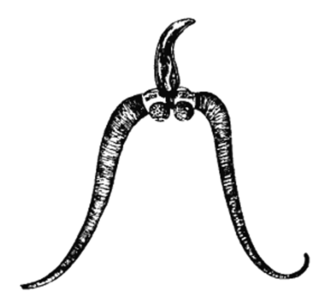
Bucephalidae is a family of trematodes that parasitize fish. They lack suckers, having instead a muscular organ called a "rhynchus" at the front end which they use to attach to their hosts. The characteristics of the rhynchus are used to help define the genera of the family. It is one of the largest digenean families, with 25 genera containing hundreds of described species. Bucephalids are cosmopolitan, having been recorded all over the world. They are parasites of fish from freshwater, marine, and brackish water habitat types.

Opecoelidae is a family of trematodes. It is the largest digenean family with over 90 genera and nearly 900 species, almost solely found in marine and freshwater teleost fishes. It was considered by Bray et al. to belong in the superfamily Opecoeloidea Ozaki, 1925 or the Brachycladioidea Odhner, 1905.

Hamacreadium is a genus of trematodes in the family Opecoelidae. It is synonymous with Olivacreadium Bilqees, 1976. Species of Hamacreadium are endoparasitic in fish such as Lethrinus Cuvier, 1829.
Allopodocotyle is a genus of trematodes in the family Opecoelidae.
Cainocreadium is a genus of trematodes in the family Opecoelidae. It has been synonymised with Apopodocotyle Pritchard, 1966, Cainocreadoides Nagaty, 1956, and Emmettrema Caballero y Caballero, 1946.
Coitocaecum is a genus of trematodes in the family Opecoelidae. It has been synonymised to Ozakia Wisniewski, 1934, Paradactylostomum Zhukov, 1972 nec Toman, 1992, and Pseudocoitocaecum Bilqees, 1972.
Dactylostomum is a genus of trematodes in the family Opecoelidae. It is synonyised with Opedunculata Dwivedi, 1975.
Decemtestis is a genus of trematodes in the family Opecoelidae. It has been synonymised with Allodecemtestis Hafeezullah, 1970.

Helicometra is a genus of trematodes in the class Opecoelidae. It is synonymous with AllostenoperaBaeva, 1968, MetahelicometraYamaguti, 1971, and StenoperaManter, 1933. Its type species is H. fasciata(Rudolphi, 1819). They are distinguished by their unique spiral uterus, from which their name is derived.
Neohelicometra is a genus of trematodes in the family Opecoelidae. It consists of only one species, Neohelicometra scorpaenae.
Neolebouria is a genus of trematodes in the family Opecoelidae.
Peracreadium is a genus of trematodes in the family Opecoelidae. It is very similar to the related genus Cainocreadium Nicoll, 1909, and has been synonymised with the genera Anabathycreadium Salman & Srivastava, 1990, Indocreadium Salman & Srivastava, 1990, and Lebouria Nicoll, 1909.
Transversotrema is a genus of trematodes in the family Transversotrematidae.
Transversotrematidae is a family of trematodes in the order Plagiorchiida. It is the only family in the superfamily Transversotrematoidea, which is the only superfmaily in the suborder Transversotremata. It has been synonymised with Circuitiocoeliidae Wang, 1981, Squamacolidae Pan & Wang, 1985, and Transversotrematinae Witenberg, 1944.
Caudotestis is a genus of trematodes in the family Opecoelidae.
Choerodonicola is a genus of trematodes in the family Opecoelidae.
Heterolebes is a genus of trematodes in the family Opecoelidae.
Maculifer is a genus of trematodes in the family Opecoelidae.
Batrachotrematidae is a family of trematodes in the order Plagiorchiida.
Opisthioparorchis is a genus of trematodes in the family Batrachotrematidae. The separation of Opisthioparorchis and Batrachotrema, originally weakened by the heterogeneity of the former, has been solidified by the separation of species presenting tegumental spines to Opisthioparorchis and those without tegumental spines to Batrachotrema. This differentiation is opposed to that of Wang (1980), who separated Opisthioparorchis on the basis of the relative positioning of the testes and their relation to the internal caeca.


